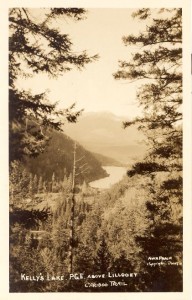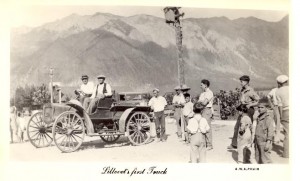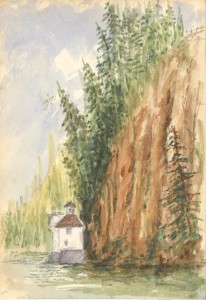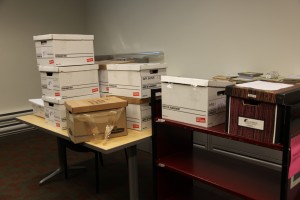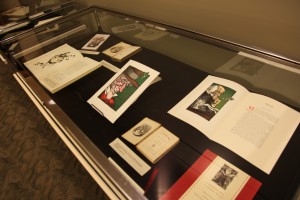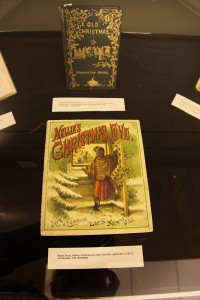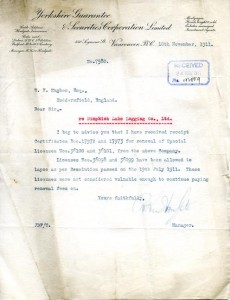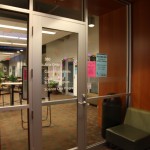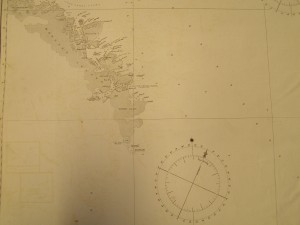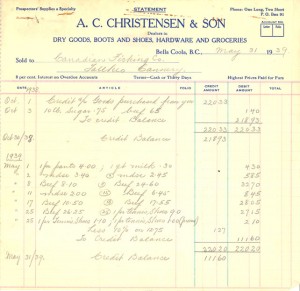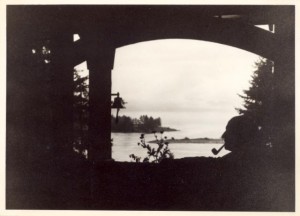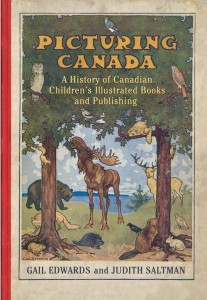Featured place: Lillooet
Posted on January 12, 2011 @9:00 am by sromkey
Happy new year, and welcome back to Rare Books and Special Collections’ series of blog posts featuring places in British Columbia based on the room names in the Irving K. Barber Learning Centre.
Our featured place for this post is Lillooet, which was founded as “Mile 0” on the Cariboo/Barkerville gold rush wagon trail. Located 340 km northeast of Vancouver, Lillooet is included in the traditional land of the St’at’imc first nation. After the Gold Rush period, the main industries in Lillooet were centered around the railway, ranching, farming and forestry.
Our featured documents are three photographic postcards from the B.C. Historical Photograph collection at RBSC. This collection can be searched through the Archives, Bibliographies and Reading Rooms section of the library catalogue, or on the RBSC site.
All three photographs were taken by the photographer Arthur Phair, and depict scenery around Lillooet, views from the Pacific Great Eastern Railway… and Lillooet’s first truck!
According to Camera Workers of British Columbia, Arthur Phair was a commercial photographer active in Lillooet from around 1920-1933. Camera Workers of British Columbia is a great (and free!) resource for identifying photographers in B.C. from 1858-1950.
In the Irving K. Barber Learning Centre, the Lillooet room (#301) is part of the Chapman Learning Commons. This beautiful room is a favorite for conferences and meetings.
Interesting Lillooet fact: Lillooet’s Bridge of 23 Camels, opened in 1981 and named by contest, is named after 23 camels brought to B.C. during the gold rush period to use as pack animals. Sadly, the camels’ soft feet were not suited to the rough wagon trails, and they were reportedly stinky and difficult to manage. Most were subsequently abandoned to roam the B.C. wilds before succumbing to cold winters or hunters.
No CommentsPosted in Collections, Uncategorized | Tagged with Barber
New documentary art collection
Posted on January 7, 2011 @2:29 pm by sromkey
A small collection of drawings and paintings from turn of the century Vancouver has been recently catalogued at Rare Books and Special Collections. The Albert Lindgren fonds contains 37 small watercolour paintings and 9 drawings, dating from ca. 1900-1903. The paintings and drawings mostly depict Vancouver-area waterfront views, as Lindgren was a ship captain.
Archives will often collect works of art which document a specific place, culture or time period. In the era before photography became so commonplace, a sketch or painting may be one of few records of what a place or landmark looked like. For example, the image below is an early depiction of the original Prospect Point Lighthouse in Stanley Park, before the seawall was built.
On the other hand, sometimes a lack of contextual information or notes by the creator leave you wondering what it is exactly you’re looking at. For example, the image below: given the content of the rest of the collection, this is very likely a waterfront scene in the Vancouver area. Possibly it’s Coal Harbour- if you think you know, leave a comment or email us at spcoll@interchange.ubc.ca and let us know!
For a large Canadian documentary art collection, much of which can be viewed online, check out Documentary Art at Library and Archives Canada.
No CommentsPosted in Collections, Uncategorized | Tagged with
Christmas for Archivists
Posted on December 23, 2010 @10:50 am by sromkey
The end of the year for an archivist can feel like… well, like Christmas! At the end of the year a lot of people get around to adding to their archives. As a little preview, next year you can expect to see additions to:
- The Douglas Coupland fonds
- The Ann Blades fonds
- The Chung Collection
- The John Keenlyside Legal Research Collection
Happy holidays and stay tuned in the New Year for new and growing collections!
No CommentsPosted in Collections, Uncategorized | Tagged with
Featured place: Fort Fraser
Posted on December 21, 2010 @9:19 am by kalsbeek
This week our featured place is Fort Fraser, British Columbia. Today, Fort Fraser, named by the explorer, Simon Fraser in 1806, is a community of about 1000 people that is active in the tourism and forestry industries.
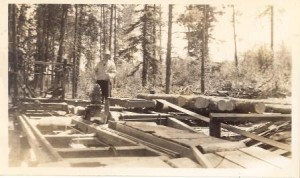
Mill at Fort Fraser, BC-1456-2-11. This photograph of a lumber mill in Fort Fraser comes from the B.C. Historical Photograph Album Collection . RBSC collects photographs both individually and as parts of larger collections. On our website you will find tutorials on how to search for photographs in our collections.
Historically, Fort Fraser played an important role in the development of British Columbia for a number of reasons, including:
- It is found near the geographical centre of British Columbia, 44 km west of Vanderhoof on The Yellowhead Highway.
- Originally established in 1806 as a North West Company fur trading post by the explorer Simon Fraser, it is one of present-day British Columbia’s oldest permanent European-founded settlements. The area around the community is also recorded as the site of the first land in British Columbia cultivated by non-First Nations people.
- The present community is located at the site of the last spike of the Grand Trunk Pacific Railway, driven on April 7, 1914.
The Rare Books and Special Collections (RBSC) reading room is named after the community of Fort Fraser. We think that it is a very fitting name for our reading room. Similar to the way in which Fort Fraser is located near the geographical centre of British Columbia, physically, the RBSC reading room is located at the heart of the Barber Learning Centre.
If you have some extra time before we close for the holidays at 3pm on December 24, please drop in to visit the RBSC Fort Fraser Reading Room and a take a look at ‘Tis the Season, a winter holiday-themed exhibition.
Posted in Collections, Exhibitions, Uncategorized | Tagged with Barber
Featured place: Nimpkish
Posted on November 30, 2010 @11:00 am by kalsbeek
Every two weeks, Rare Books and Special Collections is featuring a historic document based on a B.C. place name used in the Irving K. Barber Learning Centre. Our third featured B.C. place is the Nimpkish area. The community of Nimpkish is on the end of Nimpkish Lake, on the northern part of Vancouver Island. An area known for forestry (as part of the North island Central Coast Forest District), it is also the home of the Nimpkish Lake Provincial Park, and the traditional territory of the ‘Namgis First Nation.
The document shown comes from the Yorkshire Trust Company fonds, and the files from this collection show the establishment of the Nimpkish Lake Logging Company in the early 20th century. The files contain minutes and correspondence regarding shares and timber leases.
The Yorkshire Trust Company was based in England, but established an office in Vancouver in 1880. Being one of the first financial companies to operate in British Columbia, its records include valuable historical information on a variety of early British Columbia businesses. These records are available for consultation in the Rare Books and Special Collections division of the library.
In the Barber Centre, the Nimpkish Study Area is room 387, and is part of the Science One and Arts One area on the third floor.
No CommentsPosted in Collections, Uncategorized | Tagged with Barber
Featured place: Moresby Island
Posted on November 16, 2010 @10:09 am by kalsbeek
Our second featured place is Moresby Island. During the course of doing research for this blog post, we discovered that there are actually two Moresby Islands in British Columbia; one island is located in the Queen Charlotte archipelago and one island is located in the Gulf Islands. Our collection of early British Columbia Admiralty charts includes charts of both islands.
Moresby Island, shown on Admiralty chart 3619, is the name of one of the BC Gulf Islands and is located on the west side of Swanson Channel and east of the southern end of Saltspring Island. A small island (it is 3.7 km long and 2.2 km across), it was first settled in 1863 and was named after Rear Admiral Fairfax Moresby R.N., who was the naval commander-in-chief of the Pacific Station of the Royal Navy between 1850 and 1853.
Moresby Island, shown on Admiralty chart 1923b, is also the name of one of the 150 islands that make up the Queen Charlotte archipelago, and is much larger. It is actually the 175th largest island in the world, and the 32nd largest island in Canada. Interestingly, this island was also named for Rear Admiral Fairfax Moresby, by Moresby’s son-in-law, Commander James Prevost.
In the Barber Centre, the Moresby Room is room 185 and is located on the first floor of the Barber Centre.
No CommentsPosted in Collections, Uncategorized | Tagged with Barber
Featured town: Bella Coola
Posted on November 2, 2010 @10:09 am by kalsbeek
In a new series of blog posts, Rare Books and Special Collections will be featuring a historic document, photograph or map related to one of the B.C. towns represented in the room names of the Irving K. Barber Learning Centre.
To kick things off, we’ll start with Bella Coola which is a small town on the Central Coast of B.C. The Bella Coola area is famous for the MacKenzie Rock, where in 1793 Alexander MacKenzie wrote his name on a rock to commemorate completing the first recorded journey across North America. In the early to mid 20th century, the Bella Coola area was home to the Tallheo Cannery, which is where our featured document comes from. The Tallheo Cannery was built in 1912 by the Canadian Fishing Company. The archives of the Tallheo Cannery include administrative records such as correspondence, financial documents, and fishermen’s statements. The document shown is a receipt for purchases made by the Cannery from a Bella Coola store, A.C. Christensen & Son, who were dealers in “dry goods, boots and shoes, hardware and groceries.”
In the Barber Centre, the Bella Coola room is number 193, a meeting room on the first floor of the building.
Check back every two weeks for another B.C. town and another historic document!
No CommentsPosted in Collections, Uncategorized | Tagged with Barber
Updated archives: Garnett Weston fonds
Posted on September 30, 2010 @4:11 pm by kalsbeek
This week we’ve added a small group of material to the archives of Weston Garnett, a screenwriter, novelist and poet, born in Toronto in 1890 who eventually settled in East Sooke, Vancouver Island. A little research on Weston proves interesting: he was the screenwriter for the 1932 film “White Zombie” which among Zombie aficionados is considered to be the first-ever Zombie movie. Unfortunately, the manuscript for “White Zombie” is not part of his archives here at UBC. We do however have manuscripts of several novels, poetry, and one screenplay co-written with Zelda Sears.
No CommentsPosted in Collections, Uncategorized | Tagged with
Rare Books and Special Collections closed August 9, 2010 from 9:00 a.m. to 2:00 p.m.
Posted on July 27, 2010 @10:46 am by sromkey
Due to a special event, Rare Books and Special Collections will be closed to the public from 9:00 a.m. to 2:00 p.m. on Monday, August 9, 2010.
We thank-you for your understanding and regret any inconvenience this closure may cause.
If you have any questions, please contact us by email spcoll@interchange.ubc.ca or by phone at 604-822-2521.
No CommentsPosted in Announcements, Uncategorized | Tagged with
Picturing Canadian Children’s literature
Posted on June 17, 2010 @10:23 am by kalsbeek
A fascinating exhibition that complements the release of a new book on children’s literature is now on display at UBC Library’s Rare Books and Special Collections (RBSC) division.
Picturing Canada: Canadian Children’s Illustrated Books and Publishing, highlights Canadian picturebooks from the last 200 years. The exhibition includes rare children’s books as well as popular productions from recent years. It was curated by Shannon Ozirny, Meaghan Scanlon and Geneviève Valleau, all students at UBC’s School of Library, Archival and Information Studies.
The exhibition features highlights from Picturing Canada: A History of Canadian Children’s Illustrated Books and Publishing, written by Judith Saltman and Gail Edwards. Saltman is an Associate Professor at UBC’s School of Library, Archival and Information Studies and Chair of the Master of Arts in Children’s Literature program; Edwards is the Chair of the Department of History at Douglas College.
No Comments
Posted in Exhibitions, Uncategorized | Tagged with Barber, Children's Literature, SLAIS, Students
